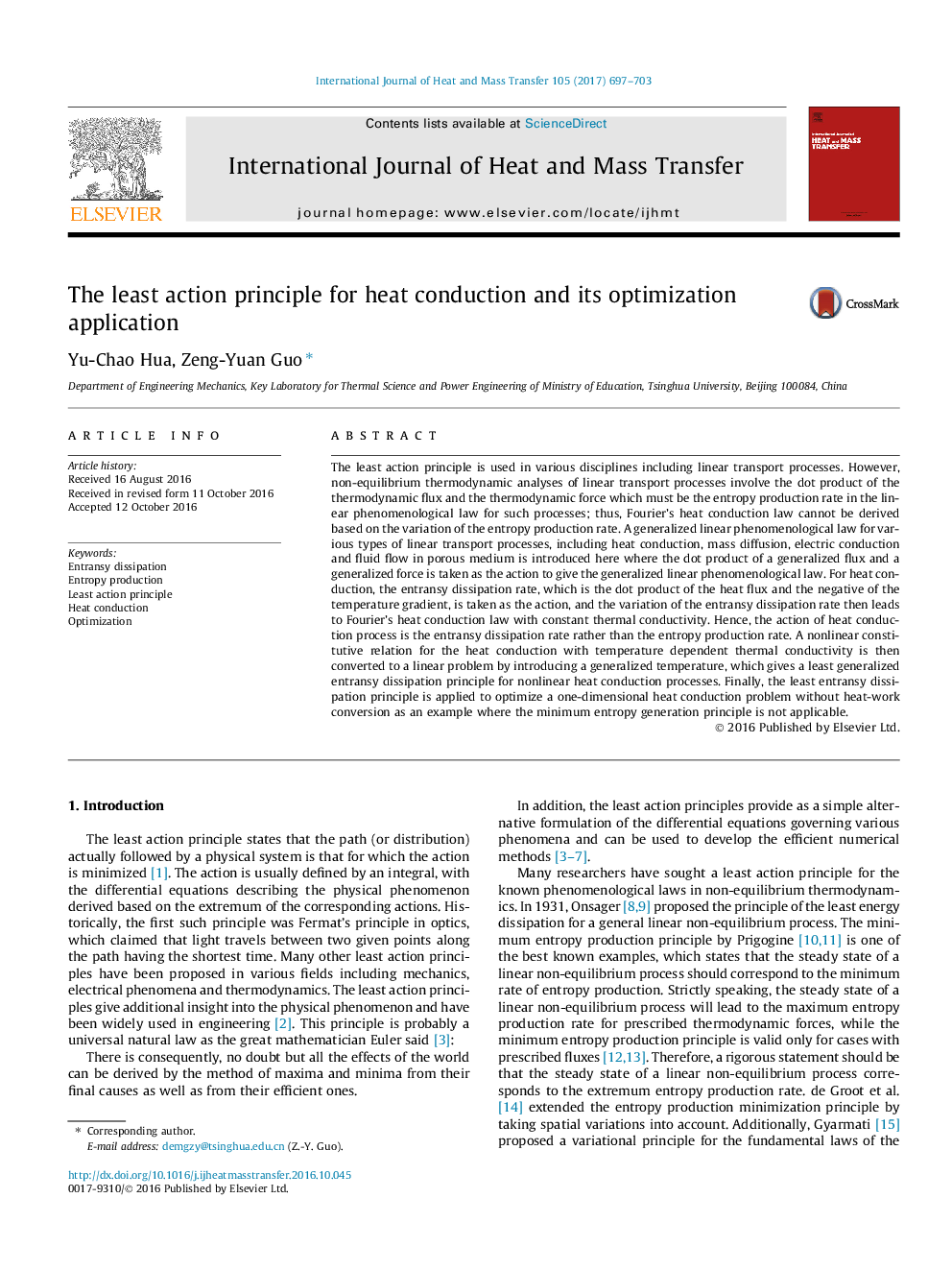| کد مقاله | کد نشریه | سال انتشار | مقاله انگلیسی | نسخه تمام متن |
|---|---|---|---|---|
| 4994725 | 1458037 | 2017 | 7 صفحه PDF | دانلود رایگان |
عنوان انگلیسی مقاله ISI
The least action principle for heat conduction and its optimization application
ترجمه فارسی عنوان
اصل حداقل عمل برای هدایت حرارتی و برنامه بهینه سازی آن
دانلود مقاله + سفارش ترجمه
دانلود مقاله ISI انگلیسی
رایگان برای ایرانیان
کلمات کلیدی
ترجمه چکیده
اصل کمترین اقدام در رشته های مختلف از جمله فرآیندهای حمل و نقل خطی استفاده می شود. با این حال، تجزیه ترمودینامیکی غیر تعادل از فرآیند حمل و نقل خطی شامل محصول نقطه شار ترمودینامیکی و نیروی ترمودینامیک است که باید نرخ تولید آنتروپی در قانون پدیده شناسی خطی برای چنین فرآیندهای باشد؛ بنابراین، قانون هدایت حرارتی فوریه بر مبنای تنوع نرخ تولید انتروپی نمی تواند برآورد شود. قانون پدیده شناسی خطی کلی برای انواع مختلف فرآیندهای حمل و نقل خطی، از جمله هدایت گرما، انتشار جرم، هدایت الکتریکی و جریان سیال در محیط متخلخل معرفی شده است که در آن نقطه تولید نقطه یک شبه عمومی و یک نیروی عمومی به عنوان اقدام به دادن قانون پدیده شناسی خطی تعمیم یافته. برای هدایت گرما، میزان تخلخل ورودی، که محصول نقطه شار گرما و منفی گرادیان درجه حرارت است، به عنوان عمل عمل می شود، و تغییر نرخ تخلیه مایع، سپس به قانون هدایت حرارتی فوریه با دمای ثابت هدایت از این رو، عمل فرایند هدایت حرارتی، میزان تخلیه مایع است، نه میزان تولید آنتروپی. یک رابطه سازنده غیرخطی برای هدایت گرما با هدایت حرارتی وابسته به دما سپس به وسیله معرفی یک درجه کلی تعمیم داده شده به یک مسئله خطی تبدیل می شود که به عنوان یک اصل انتساب حداقل انتزاعی برای فرآیندهای هدایت غیر خطی حرارت داده می شود. در نهایت، برای رسیدن به یک مسئله هدایت گرما یک بعدی بدون تبدیل حرارت کار به عنوان نمونه ای که اصل کمترین آنتروپی را قابل استفاده نمی باشد، اصل کمترین حرکت غوطه ور استفاده می شود.
موضوعات مرتبط
مهندسی و علوم پایه
مهندسی شیمی
جریان سیال و فرایندهای انتقال
چکیده انگلیسی
The least action principle is used in various disciplines including linear transport processes. However, non-equilibrium thermodynamic analyses of linear transport processes involve the dot product of the thermodynamic flux and the thermodynamic force which must be the entropy production rate in the linear phenomenological law for such processes; thus, Fourier's heat conduction law cannot be derived based on the variation of the entropy production rate. A generalized linear phenomenological law for various types of linear transport processes, including heat conduction, mass diffusion, electric conduction and fluid flow in porous medium is introduced here where the dot product of a generalized flux and a generalized force is taken as the action to give the generalized linear phenomenological law. For heat conduction, the entransy dissipation rate, which is the dot product of the heat flux and the negative of the temperature gradient, is taken as the action, and the variation of the entransy dissipation rate then leads to Fourier's heat conduction law with constant thermal conductivity. Hence, the action of heat conduction process is the entransy dissipation rate rather than the entropy production rate. A nonlinear constitutive relation for the heat conduction with temperature dependent thermal conductivity is then converted to a linear problem by introducing a generalized temperature, which gives a least generalized entransy dissipation principle for nonlinear heat conduction processes. Finally, the least entransy dissipation principle is applied to optimize a one-dimensional heat conduction problem without heat-work conversion as an example where the minimum entropy generation principle is not applicable.
ناشر
Database: Elsevier - ScienceDirect (ساینس دایرکت)
Journal: International Journal of Heat and Mass Transfer - Volume 105, February 2017, Pages 697-703
Journal: International Journal of Heat and Mass Transfer - Volume 105, February 2017, Pages 697-703
نویسندگان
Yu-Chao Hua, Zeng-Yuan Guo,
